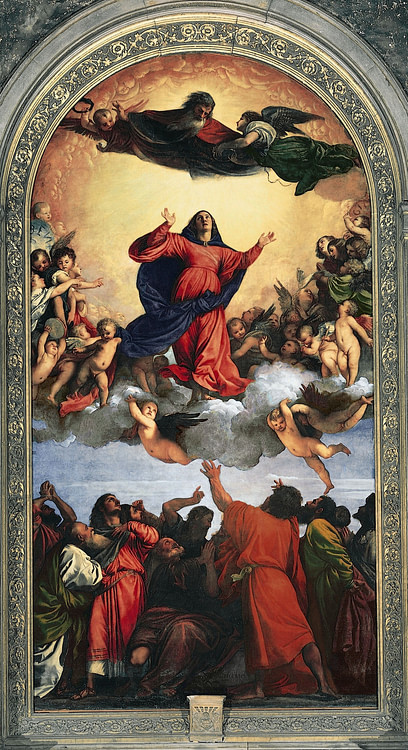Assumption of the Virgin
Artist: Titian
Nationality: Italian
Date: 1516-1518
Title: Assumption of the Virgin
Genre: Venetian Altarpiece
Medium: Oil on Panel
Size: 690 cm by 360 cm
Description
The painting depicts the ascension of the Virgin Mary into heaven, from the earth. The painting shows two distinct layers, which include the layer where the Virgin Mary is, wrapped in red robe and also a blue mantle. The same layer also contains the angelic cherubim raising Mary into the heavens while standing on the clouds. The upper layer represents God who is watching over earth and at the same time waiting for Mary, with His hair flying in the wind and the angels surround him; and also having one angle holding a crown for Mary.
The heaven where Mary is headed is suffused with golden light. Mary’s gaze is directed to heaven, where God is waiting for her, with his face painted in a style that is impressionistic (Cassidy, 1988, n.p). Some angels are clothed but some who seem younger are not clothed.
God, as painted, with the angels around Him is positioned horizontally in a manner that He can see the world clearly and in a good position. Virgin Mary is positioned vertically with her head facing upwards, obviously focusing on where she is going.
Angelic cherubim around Mary is positioned in a curve way and they make a V-shaped appearance, all witnessing the ascension of Mary and all being able to see what is happening to her. The painter also uses and maintains the continuity of outline between God and the Angles and also between Mary and the angles.
The painting is thus done at the eye level. God, Virgin Mary and the angles are in the foreground, though some angles are covered in the golden shining clouds, which form an attractive background. The painter has used mainly the color brown and red to represent his art. The texture is fine; having the robes for God, Mary and Angels and the golden clouds for the background.

Analysis
The painting is symmetrically balanced, having Virgin Mary, God and the angles surrounding Him placed at the center, while the other angles witnessing the ascension of Mary, place side by side in a perfect symmetry. The painting also has variety of colors and the images sizes, where Mary is wearing a fine robe and a blue mantle; also God is wearing a red robe, while the angles are wrapped in white and green robes.
God is depicted as an old man, with the long beard and also the hair painted white. The background golden shiny color shows appearance of the clouds in God’s Holy presence. The painted is harmonized in that the objects are simply placed in the scene and the color they are painted in is real (Baxandall, 1988, n.p).
The center of concern is on the ascending Virgin Mary, where her head is gazed at heaven where she is being waited for and her hand directed to heaven. God and all the angles are looking and witnessing at her ascension. The movement is in the way Mary is ascending into heaven and the fact that God and angles seemed to be suspended in Heaven. The painting proportion is made in a way that all the focus should be on the ascending Mary.

Interpretation
The Virgin Mary ascension carries the weight of the painting, which draws the viewer who would want to relate to the characters painted and their situation. Harmoniously, the character shown, that is God and angles; seem to coordinate at what is going on and all their attention drawn to Mary’s ascension (Baxandall, 1988, n.p). Mary on the other hand raises her hands and gazes at heaven, being eagerly awaited.
Some angles are singing as represented by an angle on the left side of the painting that seems to hold a harp, or perhaps a musical instrument to celebrate Mary’s ascension. Mary gazes at heaven as a sign of the focus she has concerning where she is going. God on the other hand looks down, with His flying hairs and He seems strict and at the same time concerned about Mary’s ascension.
Virgin Mary seems so important and heaven is happy to welcome mother of universe who helped to bring salvation to human by bearing a son who died for their sins. God is thus glad to welcome Mary after completion of a job well done. Everyone seems happy about the ascension and there is much celebration done here.
References
Cassidy, B. (1988). The Assumption of the Virgin on the Tabernacle of Orsanmichele. Journal of the Warburg and Courtauld Institutes, 174-180.
Baxandall, M. (1988). Painting and experience in fifteenth century Italy: a primer in the social history of pictorial style. Oxford University Press.